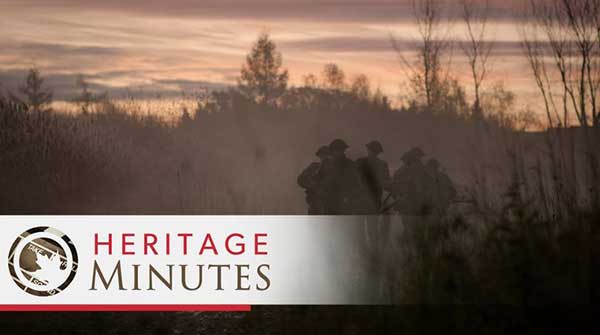The iconic Heritage Minutes collection captured captivating moments in Canadian history
 You never know what you can find in a public library.
You never know what you can find in a public library.
After dropping off my son at school one day last week, I headed to a library near our home. I hoped to find a copy of a magazine I’d meant to pick up a couple of months ago for research purposes.
My search was unsuccessful. On the plus side, I found something rather fascinating that piqued my interest almost at once.
There, tucked away among some DVDs of no particular significance that were for sale, was a brand new copy of Historica Canada’s Heritage Minutes. In the original shrink wrap, no less.
When I went to purchase it, the librarian looked at the DVD, smiled and said, “I remember enjoying these years ago!” I responded in kind, paid the (not so) princely sum of one dollar and went on my merry way.
The Heritage Minutes collection is a series of short films of 60 seconds in length depicting important moments – or snapshots, if you like – in Canadian history. They’ve been shown on TV, in movie theatres and during VIA Rail trips for over three decades.
As noted in The Canadian Encyclopedia, which operates under the auspices of Historica Canada and President/CEO Anthony Wilson-Smith, Heritage Minutes were the “brainchild” of philanthropist Charles Bronfman and the CRB Foundation. It conducted a national survey in 1986 to find out how much Canadians knew about their history. “Less than half the respondents could name the country’s first prime minister,” which would have driven Sir John A. Macdonald to drink – or, to be perfectly honest, drink more. Meanwhile, “nearly one-quarter could not name a Canadian event or achievement of which they were proud.” From an array of accomplishments in politics to sports, that’s pretty discouraging.
Bronfman was also discouraged. “He set out to create a series of history-focused public service announcements,” and the Heritage Minutes “were designed to capture attention in the manner of an advertisement. They were similar in length to commercials yet structured as dramatic narratives.”
The initial series was produced by Robert-Guy Scully, directed by Richard Ciupka and narrated by the talented broadcaster Patrick Watson. Three pilot episodes were produced in 1988, and the first 13 were released in 1991. Canadian actors like Dan Aykroyd, Graham Greene, Allan Hawco and Kate Nelligan have made appearances, along with other narrators like broadcasters Lloyd Robertson and Peter Gzowski. Funding came from organizations like Canada Post, Power Corporation of Canada and the federal government. The National Film Board of Canada participated, too.
In fact, Heritage Minutes serve the same purpose as public service announcements like the NFB’s Canada Vignettes. Without beavers meticulously building a dam, visiting a blacksmith’s shop, watching an imaginary 19th-century “episode” of News Canada and humming along to the animated short The Log Driver’s Waltz.
The DVD contains 78 of these brilliant snapshots of Canadian history. (There are now 100 in total, with the release of last year’s short film about female baseball star Mary “Bonnie” Baker.) Some would be recognized immediately. Others are a bit more obscure.
Here are but a few.
Explorer Jacques Cartier’s historical blunder of misinterpreting the Iroquois word “Kanata” (village) for Canada. Wilder Penfield’s treatment of seizure disorders, in which a female patient remarked, “I can smell burnt toast!” African American slaves taking the Underground Railroad to Canada and freedom. How a Canadian soldier’s bear, Winnie, led A.A. Milne to create a popular children’s book series. Queen Victoria and Lord Melbourne discussing responsible government. Jackie Robinson’s first baseball game with the Montreal Royals. The battle of Vimy Ridge. Robert Harris’s famous painting, A Meeting of the School Trustees, coming to life. James Naismith’s invention of basketball. Emily Murphy’s campaign to give women the vote. Cartoonist Joe Shuster’s famous creation, Superman.
“Heritage Minutes presented Canada’s history in a new and accessible way,” Craig Baird, host of the Canadian History Ehx podcast, recently told me. “For those who grew up in the 1990s, like myself, it sparked an interest in Canadian history. They showed Canadian history could be interesting. It is all in how you present it.”
I couldn’t agree more.
Watching a 60-second short film obviously won’t teach you everything that you need to know about Canadian history. It barely scratches the surface. Nevertheless, even the smallest amount of exposure to topics like politics, sports, medicine and the military can open new doors for both young and old. If it helps encourage them to read and learn more about great Canadian moments, figures, discoveries and accomplishments, then Bronfman’s original mission has been accomplished.
You can watch Heritage Minutes at Historica Canada’s website and on YouTube. Or, if you get lucky, you’ll find a copy of the DVD for sale in a public library like I did.
Michael Taube, a Troy Media syndicated columnist and Washington Times contributor, was a speechwriter for former Prime Minister Stephen Harper. He holds a master’s degree in comparative politics from the London School of Economics.
For interview requests, click here.
The opinions expressed by our columnists and contributors are theirs alone and do not inherently or expressly reflect the views of our publication.
© Troy Media
Troy Media is an editorial content provider to media outlets and its own hosted community news outlets across Canada.


